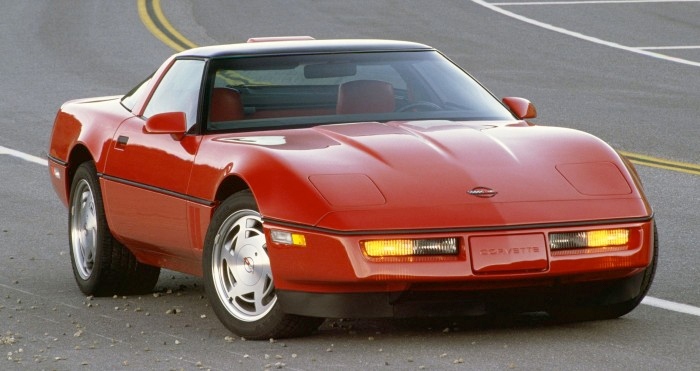Media | Articles
Why isn’t the Chevy Corvette ZR-1 worth more?
There’s good news and bad news for anybody who bought a 1990-95 Chevrolet Corvette ZR-1 brand new and still owns it.
The good news is you’re driving one of the best cars General Motors ever built, a corporate Ferrari-beater that would have cost double built by a boutique manufacturer.
The bad news is you still haven’t recovered your original investment of at least $58,995 (over $107,700 in today’s dollars) – and the highest price at auction at this time remains $48,600, achieved by Mecum for a 1995 ZR-1 on January 24, 2015 at Kissimmee.
But cheer up because ZR-1s seem to have bottomed. Most seem to sell between $20,000 and $35,000, but the newest is 20 years old, and prices are on the way up. And well they should be; the 6,939 ZR-1s are the least-appreciated Corvette and the best value in the entire lineup.
The Corvette reached its nadir in 1975, when emissions strangled the 350-cid V-8 in the C3 to a mere 165 bhp, from nearly double that, just six years earlier. With the fourth generation debuting in 1984 and the development of cross-fire fuel injection, the motor recovered, but still produced only 240 bhp in 1989.
Marketplace
Buy and sell classics with confidence
GM decided more power was vital to save the brand, and initially planned to turbocharge the existing OHV V-8. But that wouldn’t yield enough horsepower, so the decision was made to develop a double overhead cam (DOHC), four-valve engine at GM’s Lotus plant at Hethel in England.
However that motor was too wide to be installed from beneath the chassis, like previous Corvette units. So a new engine was developed with an aluminum block, and production handed to Mercury Marine at Stillwater, Okla. The company had excellent quality control and would build 18 engines a day, shipping them to Bowling Green, Ky., for installation.
The new motor was designated the LT5 and developed an astonishing 375 bhp thanks to four overhead camshafts, an 11-to-1 compression ratio and four valves per cylinder. The ZR-1 was capable of 0-60 mph in 4.3 seconds, a 13-second quarter-mile at about 110 mph and 180 mph top speed. Most significantly, the fuel injection system shut down eight of the 16 intake runners until half throttle, so the engine was powerful and flexible, with a 7,200 rpm redline.
Launched at the 1989 Geneva Salon in May, the ZR-1 was built as a coupe, with an optional targa top, and equipped only with a six-speed manual gearbox. The new King of the Hill, as it was initially known, looked like the existing C4, but differed significantly in mechanical details.
The ZR-1 tail was convex, as opposed to the regular Corvette’s concave rear, and the taillights were squared instead of circular. A small ZR-1 badge was affixed below the right rear light. But the wheels were 11-inches wide with 193 mph Z-rated 17-inch tires. To fit those tires, the rear of the car was widened three inches, which necessitated a different rear clip, doors and rocker panels.
The ZR-1 also featured perhaps the first “valet key,” with two settings. In “normal” mode the secondary intake ports were disabled, limiting the engine to about 200 bhp. In “power” mode the output rose to 375-380 bhp.
The base price of a 1990 Corvette was $31,979 and the ZR-1 package added $27,016. That package included power leather seats, 14-setting selective ride and handling, Bose stereo and low tire pressure monitor, but that only added $4,829 to a base car, which means the ZR-1 package cost $22,187. Even though it was easy to top $60,000 with a few other extras, “dealer premiums” (code for price gouging) were common, and some cars sold for $100,000.
Somehow the seed was not sown. GM built 3,049 ZR-1s in 1990, 2,044 in 1991, 502 in 1992 and 448 each of the next three years. The high price of the package was a significant factor, but GM devalued the model with several bonehead moves. While one cannot blame the corporation for raising the base LT-1 engine to 300 bhp in 1992 as rivals’ horsepower also increased, there was no excuse for fitting the ZR-1’s convex tail and square taillights to the base model.
The net effect was to devalue the investment, and several thousand ZR-1 owners suffered the same resale curve as the 1976 Cadillac Eldorado “last ever” convertibles. Accounting for inflation, those original Cadillac owners are STILL underwater.
So should you buy a ZR-1? It depends if you will drive it. The 1993-95 cars were boosted to 405 bhp, and that’s an impressive figure today. The flexible engines are a blast to drive, with maximum power delivered at 5,800 rpm. The ZR-1 is competitive with European supercars of the time and the maintenance is a bargain by comparison.
There are a number of ZR-1s on the market at any given time, and while low mileage trailer queens may have seal issues, regularly exercised cars should be fine. Some unique spares could be problematic, as production was limited (windshields are different, for example). But if you’re planning long-term ownership, hoard what you may need. As far as the Mercury Marine engines are concerned, you’ll need a good mechanic, but they turned out to be spectacularly reliable – I know of one that amassed 250,000 miles without a teardown.
Most ZR-1s have been well cared for but if you’re shopping, check for accident damage. Also, be careful that what you’re buying is a real ZR-1, not just an engine transplant from a crashed car. Real ZR-1s have “Z” as the fifth digit in the VIN, base cars have “Y.”
Except for the tiny lettering on the tail, and a different center brake light, a ZR-1 is a stealth supercar. You may feel like Rodney Dangerfield, but they’ll have to catch you to point that out.










